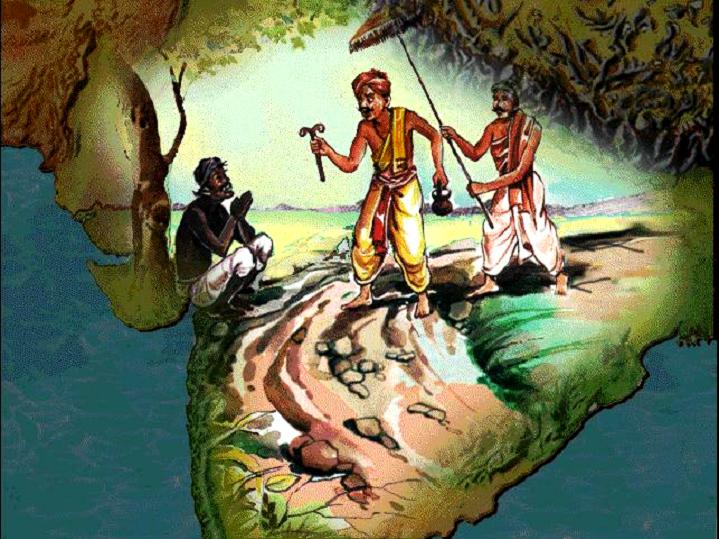As the pure-impure debate rages on social media in Manipur, it is important to note that Shantidas Gosai, the Hindu missionary, who came to Manipur early 18th century, burnt the Puya – the sacred scripture of Meiteis after converting them to Hinduism. The burning of Meitei Puyas has assaulted the culture, language, religion and social harmony of the Manipur society.

Shantidas Gosai, the Hindu missionary, who came to Manipur early 18th century, burnt the Puya – the sacred scripture of Meiteis after converting them to Hinduism. The burning of Meitei Puyas has assaulted the culture, language, religion and social harmony of the Manipur society. The notions of purity and impurity plague the sections of the society after coming in contact with Hinduism and has affected the lives of people.
The concept of untouchability or the word used for it in Manipuri is a confusing terminology. The people are denied the existence of caste within the Meitei society. It is denied because; the people of Manipur do not like the label and don’t want box themselves with other untouchables in India. Whereas, the practice and symptom of caste are seen in every part of life from birth to death.
However, the language for untouchables, the concept of “Pure and Impure” “Amang – Asheng” in Manipuri, has become a trending topic day in social media.
The word for casteism and untouchability in Manipuri is “Amang-Asheng”. The literal meaning of “Amang-Asheng” is “pure and impure” in English. The concept of pure and impure blood from birth is rather closer to the description of casteism in Vedic scriptures.
After the attempt to insert the Hindutva machinery in Manipur University by the central government and ignorantly accepted by the state government, the talk about the practices of pure and impure – Amang-Asheng- has become a talk of the day in social media among the people of Manipur. It was fuelled by the unconfirmed rumour about the construction of Rash Lila Mandop within the sacred place of Kangla. People were appalled as they want to keep the Kangla sacred for Sanamahism.
Did the Amang-Asheng exist before Hinduism arrived in Manipur or is it the same connotation of casteism or untouchables?
For the last twenty years, I have been addressing casteism and its impact on the life of people in Manipur. Every time I identify caste, I am accused of bringing casteism in Manipur. I want to help our people understand the practices of caste among the section of societies in Manipur.
Brahmins not eating food cooked by other communities, no intermarriage between Brahmins and Meiteis and other communities, restriction of temple entry to non-Brahmins are the realities of life in Manipur, yet they are not seen as caste-based discrimination. If these are not caste-based decisions, then what are they?
Meitei’s, as well other communities in Manipur, before the coming of Hinduism, had the concept of sacred places, sacred days and sacred events. The sacredness or sanctity of the belief system of Meiteis is different from the untouchability or caste system. However, it becomes mixed with the practice of casteism or untouchability after the Meitei’s adopted the Hinduism.
Amang – Asheng (pure and impure) is rather an appropriate word for a confused and mixed concept of casteism and untouchability.
The concept of a Brahmin becoming defiled in the presence of untouchables, the practice of Brahmins not eating food cooked by the untouchables never existed in Manipur. Now, this has become a part of life after Hinduism came to Manipur.
Intermarriage between the people of the valley and people of the hill has been a historical practice in the state. The kings of both the valley and hill used to have wives from both sides. There was no concept of untouchability like Meitei’s becoming defiled by marrying tribal women, as it is now after the arrival of Hinduism. Shudhikaran in Hindi, Shengdokpa in Manipuri is the word for the purification ceremony after marrying a tribal woman. This practice never existed among the Meitei society before Hinduism in Manipur.
After the arrival of Hinduism, untouchability became a part of life in Manipur. A Meitei marrying a tribal woman had to go through the purification ceremony in two ways. One uses the old practice of purification which involves asking the tribal women to drink cow dung mixed with water or cow urine. Another practice is by asking the tribal women to drink holy water collected from washing the feet of the Brahmins, which is known as pavitra choran – the holy feet of Brahmins.
Until the purification ceremony takes place, the Meitei man and the tribal woman remain unclean. Until then the parents of the man will not allow the tribal woman to enter the kitchen to cook food for them. If the parents of the man happen to die, both the man and the tribal woman will not be allowed to perform the final ritual for parents.
These social taboos never existed among the societies of Manipur before Hinduism entered society. These social taboos of Amang-Asheng become worse among the Meitei society. The untouchability extended between the royal families and general Meitei’s. It extends further between the general Meiteis and scheduled caste communities and the hill people.
Madhu Chandra is National Secretary of All India Confederation of SC/ST Organisations based at Hyderabad.